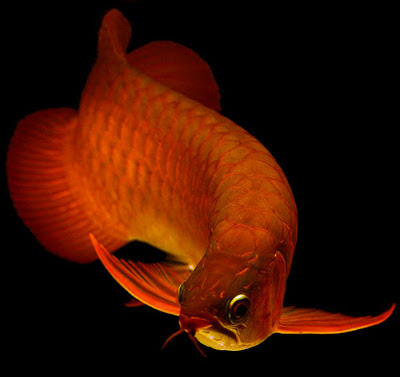Arowana is a Royal aquarium fish. It
is a bony fish of freshwater and from the family of Osteoglossidae. Sometimes
the Arowana is called as dragon fish because of its colorful, metallic and
reflective scales. The beautiful Arowanas are also known as bonytongues.
 As per I know there are only ten
described living species of Arowana from which three from South America, one
from Africa, four from Asia, and the rest two from
As per I know there are only ten
described living species of Arowana from which three from South America, one
from Africa, four from Asia, and the rest two from
The Arowana can be a great choice
for those that think something like big. The fish can grow up to 3-4 feet long
(120cm) and it can live at least 25 years. They are excellent jumpers; it has
been reported that Arowana have been seen leaping more than 6 feet from the
water surface to pick off insects and birds from overhanging branches in South America .
These popular, beautiful and royal
aquarium fish have special cultural significance in areas influenced by Chinese
culture. They believed that, it is able to ward off evil spirits and bring good
luck, happiness and wealth for the owner. Chinese people consider themselves
descendants of dragons, and many of them would pay big money, to own their very
own dragon (Arowana). There is also a superstition about the fish is that;
it’ll be benefit from the charmed Arowana by displaying pictures or images of
it. As you may know, in China
and Asia , the older the fish, the more
expensive it is, as like as a good wine. Sometimes they claim that this fish
creates positive energy. It is also said that the Arowana possess ability to
stay focus and understand human language (!).
|
Arowana fish at a glance
|
|
|
Family
|
Osteoglossidae
|
|
Subfamily
|
Heterotidinae
and Osteoglossinae
|
|
Genus
|
Scleropages
|
|
Origin
|
South America,
Africa, Asia and
|
|
Order
|
Osteoglossiformes
|
|
Class
|
Actinopterygii
|
|
Kingdom
|
Animalia
|
|
Phylum
|
Chordata
|
|
Max. Size
|
3 – 4 feet (120
cm)
|
|
pH level
|
between 7.0 and
7.5
|
|
Water
|
Keep them in
clean water
|
|
Water Conditions
|
75-86° F, KH
8-12, pH 7.0-7.5
|
|
Foods
|
small fish, crab,
crickets, Hikari pellets, insects or Shrimp (try to avoid the salt)
|


1 comment:
I find it fascinating that Arowana can breathe air and jump out of water.
Post a Comment